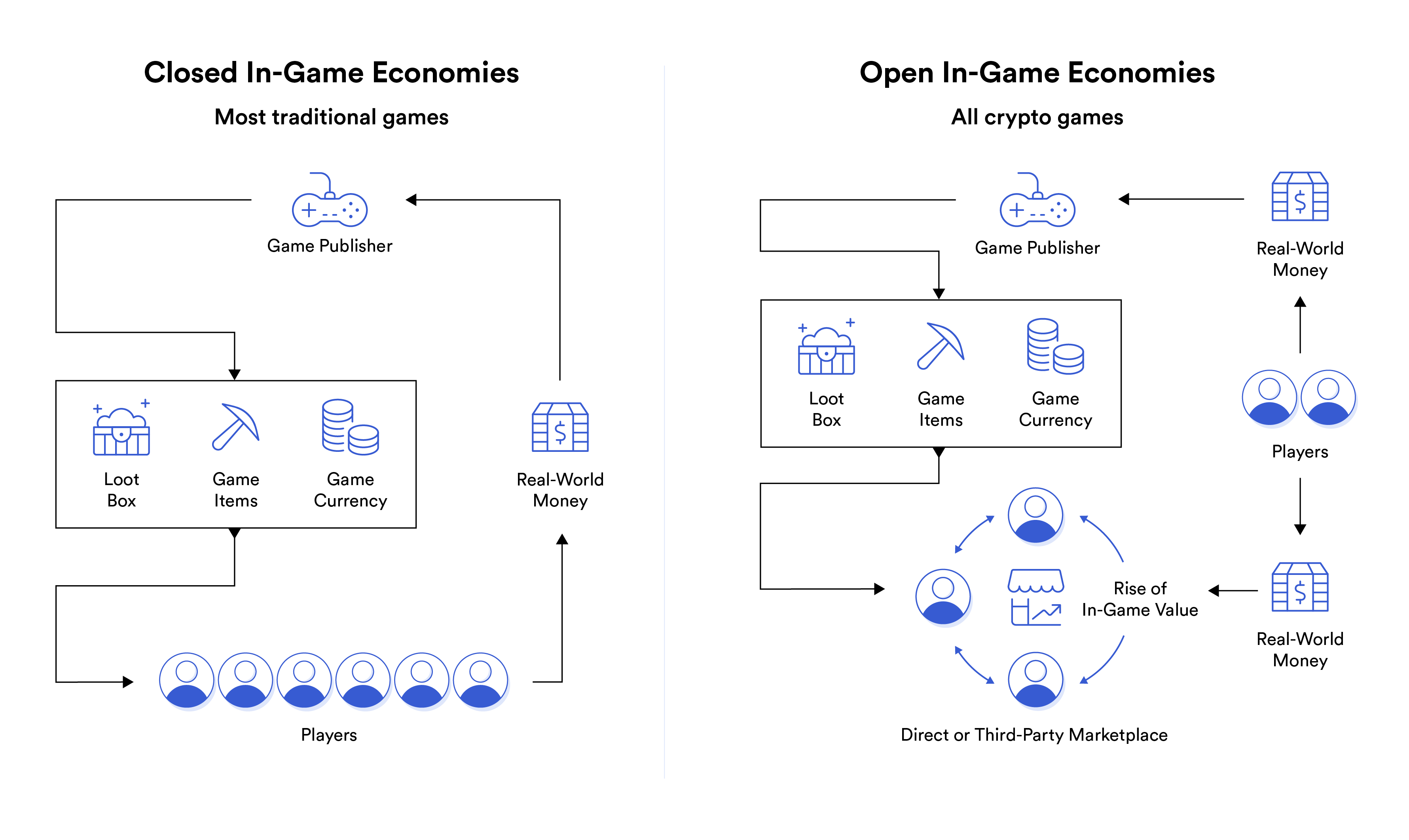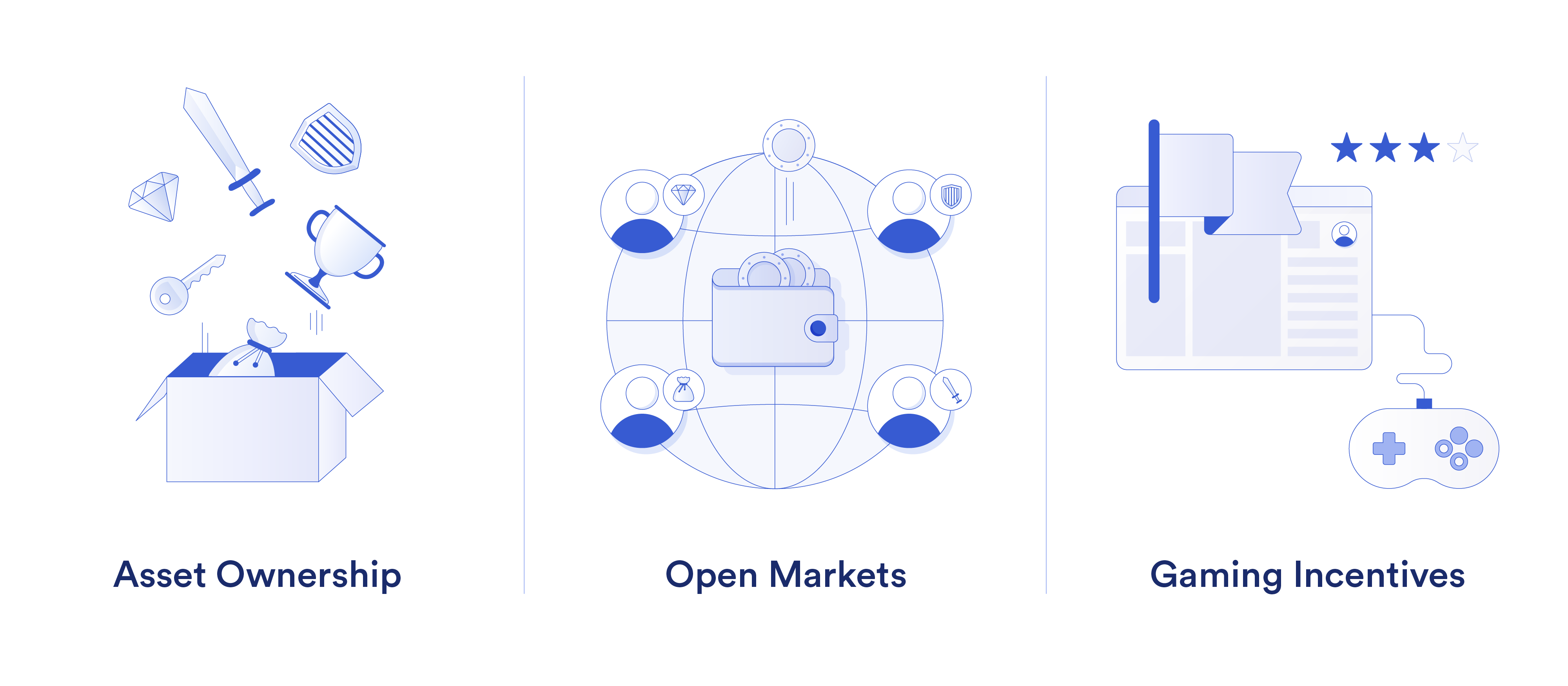What Is GameFi?
2
1
Blockchain games are creating a new status quo—one defined by open economies, sovereign user ownership, and a focus on player empowerment.
These next-gen games feature tokenized in-game items, characters, and currencies that enable players to freely trade amongst themselves.
GameFi formalizes markets that historically have been full of friction, hard to access, and banned by the vast majority of game publishers to the detriment of players.
This is in stark contrast to most video games today. The characters you play with, the skins you buy, and the items you earn are often conditionally owned. They come with strict, technologically enforced rulesets that remove or inhibit a player’s ability to exchange in-game assets. This has given rise to video game gray markets—unofficial and unsanctioned markets where valuable game assets (and even player accounts) are traded for money.

What Is GameFi?
GameFi, also known as “game finance,” was initially coined by Yearn Finance Founder Andre Cronje to refer to decentralized finance (DeFi) protocols with gamified elements. However, the term has since evolved to refer to the financial nature of blockchain games given their direct connection to real economies.
It’s no secret that game items and currencies can be valuable. The rarest CS:GO (Counter-Strike: Global Offensive) skins are valued at up to thousands of dollars, and a plethora of gray markets exist today to facilitate the exchange of in-game currency, items, or accounts for real money. On one side of the equation are the sellers—those who own these digital goods as a result of the time, money, and effort they’ve spent in the game. On the other side are the buyers—those who are willing to exchange money for the seller’s hard-earned items for a plethora of reasons (limited availability, social status, not enough time to grind, etc.)

In this context, GameFi is not a new concept. It simply uses blockchain technology to formalize a market that’s historically been full of friction, hard to access, and sometimes completely banned by game publishers. Tokens are a transformative technology aiming to replace these gated items, currencies, and even accounts.
How Blockchain Tokens Enable GameFi
Today, in-game currencies and items are typically stored and distributed by a game’s publisher on a proprietary backend server. Basically, these game items and currencies exist on a computer where the game publisher can change whatever they want. They control what players can do with their digital assets, decide who owns them, and how they can use them. That’s not the case with blockchain games.
In crypto games, blockchains are global, decentralized computers that play the role of centralized servers. Smart contracts are applications that run on top of blockchains that create and facilitate the movement of tokens—which are generally either non-fungible (NFT) or fungible.
What does this mean? Well, in-game assets underpinned by blockchain tokens set a new standard for digital asset ownership. When an in-game item is an NFT, the player owns it. It can’t be taken away or erased, and there are ways to do what anyone should be able to do with something that’s theirs—like sell it, trade it, and buy things with it—without a game developer’s explicit permission.
Why GameFi?

There are a variety of reasons why games that offer GameFi functionality could be more attractive to players.
Asset Ownership
Blockchains offer the ability to give players sovereign ownership over digital assets: Nobody can take away assets you own in your blockchain wallet. While this isn’t just a perk of GameFi but a feature of any blockchain-based asset, in-game asset ownership is a core feature of what GameFi offers to players. It’s a large part of what makes blockchain games unique.
Before blockchains, ownership was a gift—a decision considered and approved by the game’s publisher. With blockchain games and GameFi, it is a fundamental right. By changing the default of player ownership to “yes” when previously the standard was “no,” GameFi and blockchain games are reshaping the way players think about the value of their time, effort, and attention.
Open Markets
In-game items and currencies are often earned as rewards for playing the game. Whether it’s an MMORPG, a MOBA, or any other kind of social game, reward mechanisms (alongside core gameplay loops) are a key way to give players something to strive for and keep them coming back for more.
Because these items or currencies are innately able to be bought, sold, and traded on open blockchain marketplaces, players can hypothetically earn real money by playing games. And though there is no guarantee that players will be able to turn a profit, or even if the items will be worth anything in the long run, the built-in connection to a larger economy unlocks this as a possibility given the right circumstances and game economy designs.
Gaming Incentives
You have two games in front of you. Both are exactly the same game, except one offers GameFi functionality through blockchains and the other doesn’t. All things equal, you would choose the GameFi option because it offers the same benefits as the other game and more.
This is one advantage that GameFi provides to blockchain games over today’s games: Players have an additional incentive to play. While this should never take precedence over the inherent desire to play games for their entertaining gameplay dynamics, skill expression, and social benefits, the additional incentive of being rewarded for the effort you put into a game makes GameFi a little more attractive than its non-GameFi counterpart.
GameFi Examples
All items, creatures, cards, and currencies mentioned below are tokenized and can be traded on marketplaces.
Axie Infinity
Axie Infinity is a strategy game that revolves around unique, axolotl-inspired digital pets called Axies.
Players buy Axies on the open market from other players, build teams of three, and battle their teams in different game modes. They’re rewarded for winning battles and finishing missions with the game’s native game currency, SLP, which has a variety of in-game uses such as crafting runes and charms, as well as breeding new Axies.
Gods Unchained
Gods Unchained is a collectible trading card game (TCG) in which NFT cards of varying rarities can be openly bought, sold, and traded. Different cards have different abilities and statistics, and players mix and match cards to create their preferred deck.
Players use their deck within the game to battle against each other. By playing and winning games, players progress up the leaderboards and earn GODS tokens—which can be used to either purchase new card packs or staked as part of the game’s in-game governance mechanism.
Sorare
Sorare is a fantasy sports game where enthusiasts from around the world can collect NFT player cards and enter into tournaments that are based on real-life player performance in prominent sports leagues around the world, much like normal fantasy sports leagues.
Sorare players join a league and pick their line-up for each game day. Points are earned for their line-up’s performance as well as each card’s rarity—players receive increasing point boosts as card rarities go up. New cards are sold in an auction-style format and also rewarded to players for winning tournaments.
What GameFi Is Really About
Even though GameFi introduces the (mostly) novel concept of monetary incentives to video games, the most important element of any game is its ability to entertain, immerse, and connect.
GameFi economies simply create a new standard for game developers to empower players who like a game and work hard to advance within it. Oftentimes, players will hear that GameFi is heralding a new player economy—one where players can replace their daily work just by playing games. While that might be possible in specific and unpredictable circumstances, the larger story behind GameFi is that it brings a form of tangibility to digital assets.
All physical products are tradable. Handing someone a pen at school, selling your Magic the Gathering card to a friend, gifting an old school jacket to your child—these are all examples of transactions that are impossible to stop because that’s how the physical world works. GameFi is bringing this same concept to the digital world. Now, players can build economies around in-game items and currencies that are rightfully theirs.
The post What Is GameFi? appeared first on Chainlink Blog.
2
1
 Manage all your crypto, NFT and DeFi from one place
Manage all your crypto, NFT and DeFi from one placeSecurely connect the portfolio you’re using to start.






